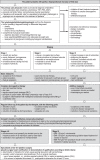Lipedema-Pathogenesis, Diagnosis, and Treatment Options
- PMID: 32762835
- PMCID: PMC7465366
- DOI: 10.3238/arztebl.2020.0396
Lipedema-Pathogenesis, Diagnosis, and Treatment Options
Abstract
Background: Lipedema is often unrecognized or misdiagnosed; despite an estimated prevalence of 10% in the overall female population, its cause is still unknown. There is increasing awareness of this condition, but its differential diagnosis can still be challenging. In this article, we summarize current hypotheses on its pathogenesis and the recommendations of current guidelines for its diagnosis and treatment.
Methods: This review is based on publications about lipedema that were retrieved by a selective search in the MEDLINE, Web of Science, and Cochrane Library databases.
Results: The pathophysiology of lipedema remains unclear. The putative causes that have been proposed include altered adipogenesis, microangiopathy, and disturbed lymphatic microcirculation. No specific biomarker has yet been found, and the diagnosis is currently made on clinical grounds alone. Ancillary tests are used only to rule out competing diagnoses. The state of the evidence on treatment is poor. Treatment generally consists of complex decongestive therapy. In observational studies, liposuction for the permanent reduction of adipose tissue has been found to relieve symptoms to a significant extent, with only rare complications. The statutory healthinsurance carriers in Germany do not yet regularly cover the cost of the procedure; studies of high methodological quality will be needed before this is the case.
Conclusion: The diagnosis of lipedema remains a challenge because of the hetero - geneous presentation of the condition and the current lack of objective measuring instruments to characterize it. This review provides a guide to its diagnosis and treatment in an interdisciplinary setting. Research in this area should focus on the elucidation of the pathophysiology of lipedema and the development of a specific biomarker for it.
Figures



Comment in
-
The Prevalence Was Probably Overestimated.Dtsch Arztebl Int. 2021 Jan 22;118(3):39. doi: 10.3238/arztebl.m2021.0059. Dtsch Arztebl Int. 2021. PMID: 33759756 Free PMC article. No abstract available.
-
Stemmer Sign Needs to be Recorded and Interpreted Correctly.Dtsch Arztebl Int. 2021 Jan 22;118(3):39. doi: 10.3238/arztebl.m2021.0058. Dtsch Arztebl Int. 2021. PMID: 33759757 Free PMC article. No abstract available.
References
-
- Földi M, Földi E, Strößenreuther R, Kubik S. Urban & Fischer. München, Germany: 2012. Lipedema Földi‘s textbook of lymphology: for physicians and lymphedema therapists 3rd Edition; pp. 364–369.
-
- Meier-Vollrath I, Schneider W, Schmeller W. Lipödem: Verbesserte Lebensqualität durch Therapiekombination. Dtsch Arztebl. 2005;102:A1061–A-1067.
-
- Forner-Cordero I, Szolnoky G, Forner-Cordero A, Kemeny L. Lipedema: an overview of its clinical manifestations, diagnosis and treatment of the disproportional fatty deposition syndrome—systematic review. Clin Obes. 2012;2:86–95. - PubMed
-
- Deutsche Gesellschaft für Phlebologie D. S1-Leitlinie Lipödem. AWMF. 2015
Publication types
MeSH terms
LinkOut - more resources
Full Text Sources
Medical

